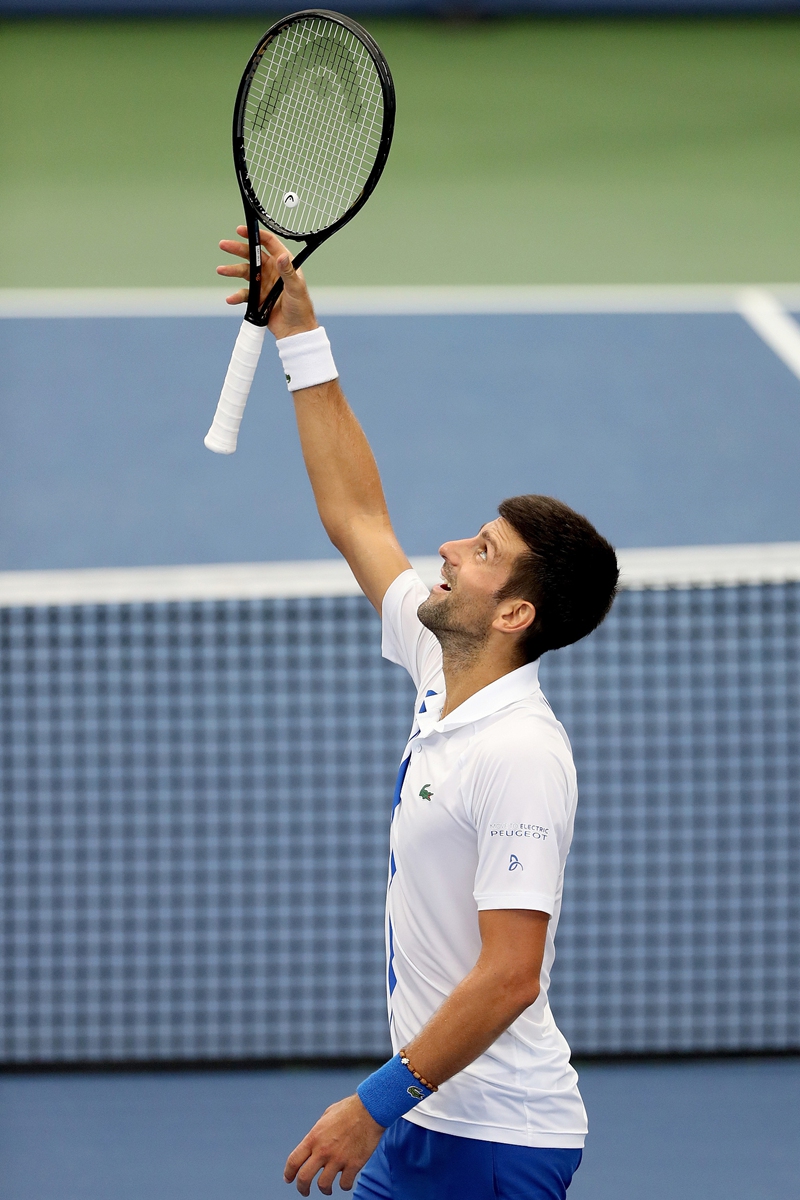Chasing history
Source: AFP Published: 2020/8/30 16:48:41
Djokovic, Williams eye Grand Slam titles in US Open COVID-19 bubble

Novak Djokovic of Serbia celebrates his win over Milos Raonic of Canada in the men's singles final of the Western & Southern Open at the USTA Billie Jean King National Tennis Center on Saturday in New York City. Photo: VCG
The US Open becomes the first Grand Slam of the COVID-19 era when it starts Monday in a spectator-free bubble at Flushing Meadows following a troubled build-up that saw several top stars withdraw over coronavirus fears.
Novak Djokovic and Serena Williams headline a tournament that will be unrecognizable from previous Slams due to strict safety protocols that were still not enough to convince some of tennis' biggest names to travel to New York.
Defending champion Rafael Nadal and women's No.1 Ashleigh Barty are among high-profile absentees at the US National Tennis Center, which just months ago was transformed into an emergency coronavirus field hospital.
Raucous crowds are a hallmark of the US Open, but this time the cavernous Arthur Ashe Stadium will be eerily empty to mitigate the risk of infection from the deadly pandemic that has wiped out much of the tennis season, including Wimbledon.
The players are being kept in a tightly controlled environment with regular COVID-19 testing throughout the tournament. Any competitor who tests positive once the event has started will be automatically withdrawn.
Most competitors are staying at one of two hotels where they will be shuttled the 30 minutes to and from the tennis center.
A few, including Djokovic and Williams, have chosen to stay in private homes where they must pay for 24-hour security approved by the United States Tennis Association (USTA).
The security teams are obliged to provide the USTA with information regarding when the player leaves and arrives at the house.
No player is allowed to travel anywhere other than between the tennis center and their accommodation. Any player who leaves the bubble without the written consent of organizers will be thrown out of the tournament.
'Safe'
Temperature checks are mandatory for everyone entering the US Open site, which is dotted with hand sanitizer machines and signs warning everyone to keep six feet from each other.
Players are to wear masks when not playing or eating, while ball persons and lines officials will wear face coverings on court on the Ashe and Louis Armstrong stadiums.
There will be no lines officials on the outer courts, where Hawk-Eye technology will make line calls.
Organizers are limiting the locker rooms to 30 players at one time, with competitors encouraged to shower and then head outside as quickly as possible where activities including basketball hoops have been put up.
Briton Andy Murray, the 2012 US Open champion, said the atmosphere felt "pretty sad," but he praised the precautionary measures.
"It feels safe and I'm happy I decided to come," he told reporters in an online press conference.
The absence of world No.2 Nadal due to coronavirus concerns and Swiss legend Roger Federer, who is recovering from knee surgery, hands Djokovic a golden chance to close the gap on his fierce rivals in the records race.
Djokovic has captured five of the past seven men's singles Slam crowns and is overwhelming favorite to capture a fourth US Open title in September 13's final.
A win on the hard courts would take the 33-year-old to 18 Grand Slam titles, behind Nadal on 19 and Federer on 20.
The Serbian, who overcame a neck injury to lift the ATP Western & Southern Open on Saturday, begins his quest against Bosnia and Herzegovina's 107th-ranked Damir Dzumhur on Monday evening.
Asterisk?
He could meet fourth seed Stefanos Tsitsipas or world No.7 Alexander Zverev in the semifinals before a possible championship match against Austrian second seed Dominic Thiem, who pushed Djokovic to five sets before falling in this year's Australian Open final.
Djokovic said it will be strange without the "explosive" energy of 22,000 fans packed into Arthur Ashe Stadium but that more downtime was a positive.
"It's strange to see empty stands. The circumstances are very unusual," he said. "But we have to accept that, we have to deal with it and try to embrace it."
A depleted women's field hands Williams a gilt-edged opportunity for a 24th career Grand Slam title to match Margaret Court's all-time record.
Women's world No.2 Simona Halep is missing, as is reigning US Open champion Bianca Andreescu of Canada and top-10 players Elina Svitolina, Kiki Bertens and Belinda Bencic.
Williams, 38, has a tricky draw though. She could meet 2017 US Open champion Sloane Stephens in the third round, Australian Open champion Sofia Kenin in the semifinals and potentially Czech top seed Karolina Pliskova in the final.
For Williams, who lost in the US Open and Wimbledon finals each of the past two years, a diminished field doesn't devalue the title.
"It still has to be tennis that's played, asterisks or not. I think this whole year deserves an asterisk because it's such a special year," she said.
RELATED ARTICLES:
Posted in: TENNIS